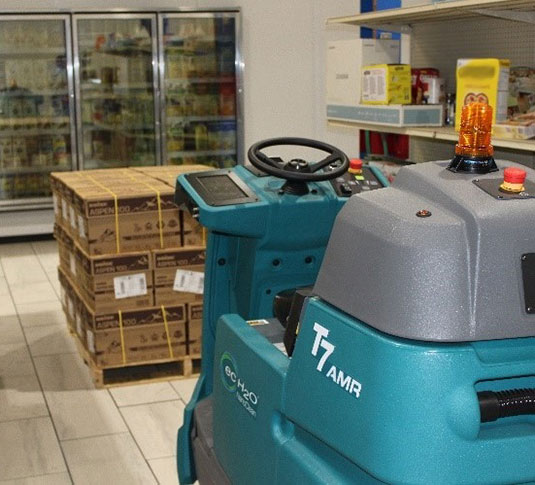Your shopping cart is empty.
How Does a Robotic Cleaning Machine See?
Posted in Robotic Cleaning Machines, Innovation & Technology,
Robotic Cleaning Obstacle Detection and Avoidance
Compared to a typical Tennant cleaning machine, a robotic cleaning machine is much more involved due to the sensors, cameras and software needed to safely and correctly operate it.
It’s fairly obvious how to operate one of our ride-on floor scrubbers or sweepers, as they are built similarly to cars with gas and brake pedals, a steering wheel and other commonly-used components we manage on a daily basis.
Robotic cleaning machines look similar to a typical ride-on cleaning machine — in fact, the T7AMR can be manually operated by a person — but have integrated technologies that allow it to clean autonomously, which means it needs to be safe enough to work alongside people in real world environments like grocery stores, malls, airports and more.
The primary safety component integrated into our T7AMR scrubber is a set of three different types of cameras that provide the ability to identify the environment of deployment, localize the scrubber in the environment, and detect and avoid obstacles, whether it’s a cardboard box or a person, in front of or on the sides of the cleaning machine. These cameras also prevent the machine from continuing to operate when unexpected obstacles show up in front of it, such as a shopping cart in an aisle, or approach it from the side, such as a person attempting to touch or get on the machine.
The 3 types of cameras we use on our autonomous cleaning machines are:
LIDAR Sensors (2):
The LIDAR (Light Detection and Ranging) sensors accurately scan the area in front of and to the sides of the machine. These sensors are located approximately 4” and 36” from the ground so they can scan for a wide range of potential obstacles.
3D cameras (3):
The three 3D cameras allow the cleaning machine to know the environment around it and especially detect any potential safety hazards.
2D cameras (3):
The three 2D cameras, located on the front and sides of the machine, are able to take photos of the home markers that the robotic cleaning machine relies on to complete cleaning routes, in addition to taking photos of obstacles that can be sent to cleaning staff to be addressed.
How does it all work together?
Once the robot is taught a cleaning route, the operator drives it to the home marker, selects which route it should clean, and presses the start button.
The T7AMR then follows the path it was trained to clean, and uses the set of cameras to ensure nothing unexpected is interrupting the route, such as a temporary store display, a shopper, a dropped box of diapers or a piece of luggage laying on the floor. If there is such an obstacle, the scrubber’s sensors will see it far in advance of meeting it, and the machine will stop operating until the obstacle is moved out of the way.
In the event that the obstacle does not move within a set amount of time, the machine will send a help signal to the operator so they can physically remove the obstacle. Once it’s removed, the machine can resume its mapped cleaning route.
If you are considering robotics for your facilities, these safety features will instill confidence in your staff, customers and other visitors while giving you the confidence of consistent, reliable cleaning.


